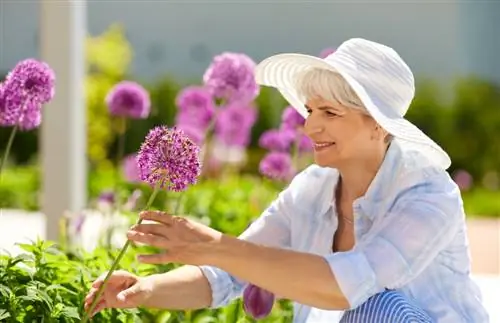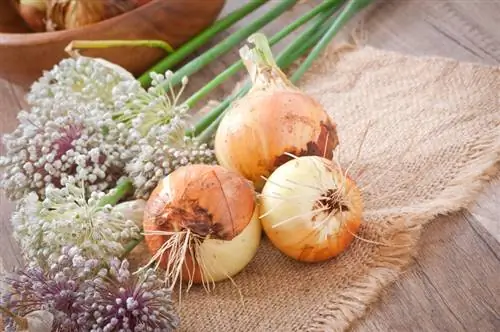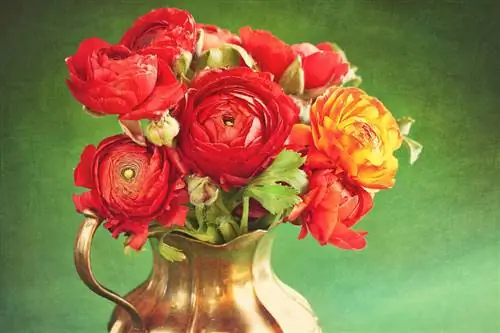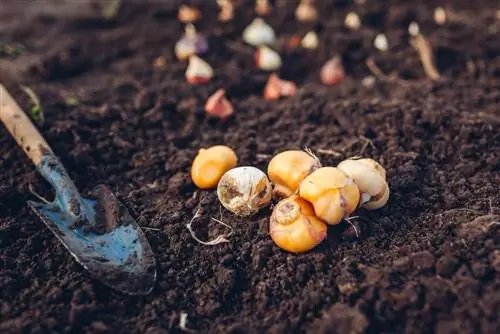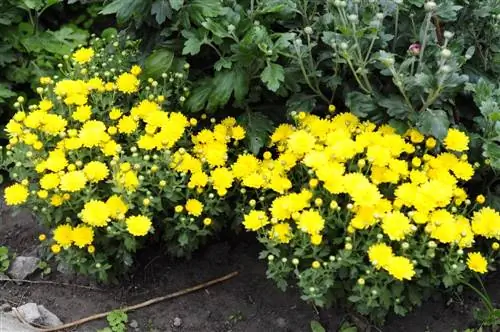- Author admin [email protected].
- Public 2023-12-25 17:45.
- Last modified 2025-01-23 11:21.
Whenever you hear the word “leek”, you first think of the tasty and he althy vegetable that is particularly popular in the winter months and enriches many dishes. Closely related to this are the various types of ornamental allium, which can be found in many flower beds because of their large, usually bright purple flower balls. You can find out how to plant them, care for them and cleverly combine them with other plants in the following article.
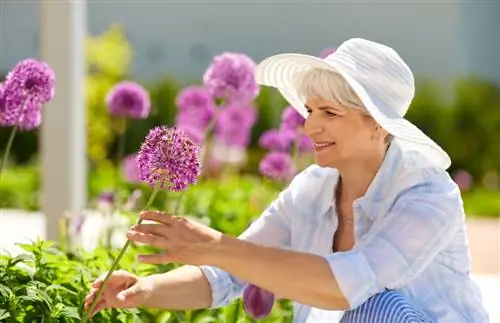
How do you plant and care for ornamental garlic in the garden?
Ornamental onion requires a full sun and dry location as well as well-drained, humus-rich soil. The planting time is between September and November. Water the plants only when necessary and fertilize them regularly with compost. Only cut off spent stems and dried leaves when they are completely dry.
Origin and distribution
Allium plants are at home all over the world, with the vast majority of species being found in the northern hemisphere of the earth. Only a few species are native to Germany, including wild garlic (Allium ursinum), which grows wild in mixed and beech forests. Ornamental garlic, on the other hand, originally comes from Central Asia, where its wild forms grow in the vast steppes and mountains. The first plants came to Europe with the Crusaders and soon found their way into the gardens of monasteries and later also into cottage gardens. The majority of the approximately 35 commercially available species are specially bred hybrids. But species such as the Iranian leek (Allium aflatunense) and the star ball leek (Allium christophii) are also very popular.
Usage
The types of ornamental onions also include the onions (Allium cepa), which are usually cultivated as pure crops, as well as garlic (Allium sativum), leeks (Allium ampeloprasum or porrum) and chives (Allium schoenoprasum). All of them belong to the large Allium family, which includes around 950 different species. In contrast to crop plants, ornamental garlic is only used as a border plant because of its striking flowers, even though it is also edible.
Appearance and growth
Ornamental onions are so-called onion flowers that, depending on the type and variety, reach heights of up to 150 centimeters. However, some species such as the blue-tongue leek (Allium nevskianum) remain significantly smaller, averaging 12 to 15 centimeters in height. The popular giant leek (Allium giganteum) reaches the most impressive height.
Like all onion flowers, the ornamental onion sprouts from the bulbs in spring. However, the above-ground parts of the plant - the foliage and the flower stems - die after flowering and seed ripening, while the onion overwinters in the soil as an underground storage organ and sprouts again the following spring. The growing season usually lasts about three to four months.
leaves
The bulb usually produces a long, leafless flower stem and long, narrow and mostly sessile leaves. The flower shaft is also surrounded by a bract that is intended to protect the stem during sprouting. However, it dries quickly the larger and stronger the shaft becomes.
Bloom and flowering time
Most ornamental garlic species bloom between May and June, although later-flowering varieties are also available commercially. The large flower umbels typically have a spherical shape in which many small individual flowers are grouped together to form eye-catching inflorescences with diameters of up to 25 centimeters. The vast majority of ornamental garlic varieties bloom in shades of purple, but some cultivars stand out with flowers in white, pink, red, yellow or even blue.
Furthermore, ornamental garlic flowers are used in fresh bouquets as well as in dry bouquets that last for many months.
Fruits
Due to its high nectar content, ornamental garlic is a popular food plant for bees, bumblebees, butterflies and other insects. These fertilize the flowers, whereupon capsule fruits form. These contain tiny, spherical, black seeds.
Is ornamental garlic poisonous?
Although the ornamental onion is planted exclusively as an ornamental plant in the flower garden, just like its relatives it is non-toxic and can even be used in many ways in the kitchen. Both the onions, the leaves and even the flowers can be used in salads, stews or for seasoning, although the taste of this plant is of course not as intense and tasty as that of edible onions and conventional leeks - after all, the breeders focus more on it the beauty of the flowers and less on the aroma. The delicate flowers look very pretty as an edible decoration on salads and other dishes.
Only dogs are not allowed to eat leek - as well as other Allium species - as they are poisonous to four-legged friends in higher doses. The ingredients of the plant, which are found in concentrated form mainly in the onions, can decompose the red blood cells of the four-legged friends. By the way, many other animals, including rodents such as rabbits and guinea pigs, instinctively avoid onion plants.read more
Which location is suitable?
Almost all types of ornamental garlic need a full sun and dry location. After all, the wild forms come from the dry steppe and stony mountain regions of Asia, where they often thrive in very exposed and barren places.read more
Floor
Allium species often thrive in garden locations where other flowers struggle. The soil should be well-drained, dry, humus-rich and as loose as possible. The ornamental onion cannot tolerate wetness or excessive moisture; here it rots quickly and dies. Plant the bulbs in locations where tulips also thrive. Heavy, clayey surfaces are not suitable.
Planting ornamental onions correctly
Plant the Allium bulbs in a suitable location, although the soil should first be loosened accordingly and improved if necessary. Loamy soil, for example, can be improved with coarse sand and compost so that rainwater drains away better. The planting hole is about three times as deep as the bulb is high. Be sure to plant the end with the roots facing down. Mark the planting locations with a stick or something similar to avoid damaging the bulbs during any ground work.read more
What is the best time to plant?
It is ideal to plant the bulbs early between September and November, and if possible they should take root before the first frost. The only exceptions are early-sprouting ornamental garlic varieties such as 'Purple Sensation', for which an early planting date would also result in very early shoots - with the risk of them freezing due to (late) frosts.
The correct planting distance
The planting distance varies between the types and varieties of ornamental garlic and essentially depends on the respective height and width of growth. The 'Globemaster' variety, which grows to around one meter high, should be planted in the bed at a distance of around 20 centimeters. You can therefore plan groups of 24 to 26 plants per square meter. The giant ornamental onion even needs up to 40 centimeters of space per plant (10 to a maximum of 20 plants per square meter), while the short but quite wide blue-tongue leek also requires a distance of 20 to 25 centimeters.
Sowing
Ornamental garlic can also be propagated very well using seeds, which you can get from the ripe seed capsules or buy in stores. The ideal time for sowing is March to April, because the cold germinator needs a phase with temperatures of less than ten degrees Celsius. The cold stimulus breaks the germination inhibition as soon as the temperatures subsequently rise. Sow the seeds directly into the well-prepared bed, mixing compost into the potting soil. Place two seeds in a planting hole about one centimeter deep and only cover them loosely with soil. Pricking out later if necessary so that the plants are not too crowded.read more
Advance
Of course, ornamental garlic can also be grown on the windowsill at home, but this project is unnecessary for several reasons. On the one hand, once the plants have germinated, they grow very quickly and flower just as quickly. On the other hand, it is difficult to germinate the seeds indoors. To do this you would have to
- store the seeds harvested in autumn in a moist and warm place over the winter
- ventilate regularly and check for mold
- Store in the vegetable compartment of the refrigerator for eight weeks from December / January
- and only sow in seed pots from March
It will be easier if you plant the seeds directly in the bed immediately after the summer harvest, where they can then germinate and grow next spring. You don't even need to harvest the seeds yourself (€4.00 on Amazon): ornamental onions have a strong tendency to self-sow as long as the location and growth conditions are right.
Watering ornamental onions
Ornamental onions do not need additional watering as the plants, which come from dry areas, cannot tolerate excessive moisture. But even if the plants only need a little water, they must not dry out.
Fertilize ornamental onions properly
Instead, fertilizer is essential for beautiful flowers. Humus or compost is very suitable and is added directly to the planting hole when planting. In spring, further fertilization is carried out with compost or self-made plant manure, with a mixture of nettle and comfrey manure being particularly suitable.
Cut ornamental onions correctly
Under no circumstances should you cut dried and faded ornamental onions too early, as the nutrients still contained in the above-ground parts of the plant are absorbed by the bulb and needed for sprouting next year. Therefore, only cut off the leaves when they have completely dried out. You can leave the inflorescences standing even longer, as they still look attractive even when they have faded. However, whether you leave the seed heads or remove them remains your decision: If you don't want the ornamental onion to go to seed under any circumstances, cutting it off makes sense.read more
Propagate ornamental onions
Ornamental garlic is very easy to propagate yourself. You can use the seeds for this - or the daughter bulbs that each bulb produces. These offshoots, also known as breeding onions, develop directly on the mother onion and can easily be detached from it in autumn and planted separately. To do this, cut off the above-ground parts of the plant close to the ground and carefully dig out the spring onions without damaging them. Breeding onions are suitable for propagation if they are thick, plump and white.read more
hardy
Not all types of ornamental garlic are hardy, which is why they overwinter differently. Frost-hardy varieties simply need to be cut down in autumn and covered with brushwood, while onions that are not hardy need to be dug up and kept in a cool, dark place over the winter. The few frost-sensitive species are often easier to cultivate in a pot that you simply place in the cool cellar in autumn and clear out again in spring.read more
Pests
Like all Allium species, ornamental garlic is often attacked by the large onion fly (Merodon equestris). In addition to this, there are two other species of flies, Eumerus tuberculatus and Eumerus strigatus, which, like the large onion fly, lay their eggs on the onion. After the maggots hatch, the onion serves as food for them, is eaten away and eventually rots. Prevent spreading by never throwing rotten spring onions into the compost. If an infestation has already occurred in one location, do not plant new onions in the same place.
Since the flies don't like carrots, they can be kept away by regular watering with a carrot herb decoction. The principle is already known from the kitchen garden, whereby onions should always be cultivated together with carrots.
The black weevil also likes to taste the onions, while aphids and snails tend to feast on the above-ground parts of the plant.
Ornamental onion is not blooming, what should I do?
The large ornamental allium species in particular tend to become lazy after just a few years. This is often due to a nutrient deficiency, which can be remedied by regular fertilization. But if that doesn't help, other causes come into question. Drought in spring, pest infestation, moisture and the associated rotting bulbs are possible reasons for the lack of flowering.
Sometimes it helps to change the location by digging up the bulbs in the fall and replanting them in a new, possibly more suitable spot in the garden. To do this, mix the excavated material well with compost and horn shavings to stimulate new shoots next spring.
Tip
If you regularly supply the ornamental onion with crushed eggshells, it will bloom even more beautifully.
Species and varieties
There are around 900 different types of ornamental garlic with numerous varieties worldwide. We have put together the most beautiful ones for your home garden here.
- Purple ball garlic 'Purple Sensation' (Allium aflatunense): up to 90 centimeters high, flower balls up to ten centimeters in diameter
- Golden leek 'Jeannine' (Allium moly): bright golden yellow, flat inflorescences, up to 35 centimeters high, for shady locations
- Garnet ball garlic (Allium atropurpureum): wine-red flower color, growth height up to 80 centimeters
- Blue ornamental garlic (Allium caeruleum): very early flowering period from March, gentian blue flower color
- Star ball leek (Allium christophii): growth height up to 40 centimeters, amethyst-colored flowers up to 25 centimeters in size
- White Bluetongue Leek 'Ivory Queen' Allium (karataviens). Growth height up to 25 centimeters, white flower balls up to 15 centimeters in size
- Giant leek 'Ambassador' (Allium giganteum): growth height up to 200 centimeters, purple-violet flower balls
- Giant leek 'Globemaster' (Allium giganteum): growth height up to 200 centimeters, purple-violet flower balls
- White giant leek 'Mount Everest' (Allium giganteum): growth height up to 120 centimeters, green-white flower balls
- Dwarf ornamental onion (Allium oreophilum): growth height up to 15 centimeters, carpet-like growth, carmine pink flowers
- Rose garlic (Allium ostrowskianum): growth height up to 25 centimeters, large, carmine pink flower balls
- Lilac garlic (Allium pulchellum): late flowering period between July and August, height up to 40 centimeters, numerous lilac-colored flowers
- Wild garlic (Allium ursinum): also wild garlic, for shady locations, growth height up to 30 centimeters, white flowers

